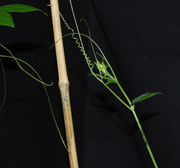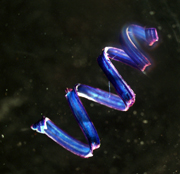HMC Professor’s Investigation of Cucumber Tendrils Reveals Possible Adaptive Spring
August 30, 2012
Sharon Gerbode/Joshua Puzey
Imagine a spring that relaxes or tightens its hold depending on how far it is stretched. Such an adaptive device might be possible according to breakthrough biophysics research conducted by Harvey Mudd College’s Assistant Professor of Physics Sharon Gerbode during her postdoctoral fellowship at Harvard University.
Gerbode and collaborators Joshua Puzey, Andrew McCormick and L. Mahadevan studied how the cucumber tendril coils into its characteristic corkscrew shape as it hoists the climbing plant toward sunlight. They not only discovered the internal mechanism that drives tendril coiling, but also an interesting twist: tendrils that were compliant when pulled slightly but much stiffer if pulled farther.
Their findings are detailed in “How the cucumber tendril coils and overwinds,” a paper co-authored by Gerbode and scheduled for publication in the August 31 issue of Science.

Sharon Gerbode/Joshua Puzey
“Cucumber tendrils coil into a right-handed helix connected to a left-handed helix, connected by a small, straight segment. This connection causes unusual behavior when a tendril is pulled,” Gerbode said. “Darwin was the first to point out that the tendril looks like a spring-but what kind of spring is it? It’s a twistless, adaptive spring that self-adjusts from soft at small extensions to very stiff at large extensions.”
The team found that the tendril’s shift from a straight to a helical coiled shape is caused by an internal “fiber ribbon” composed of two layers of stiff fiber cells. A chemical process called lignification causes one layer of cells in the ribbon to shrink relative to the other, producing the curved shape.

The team recreated the coiling mechanism in a physical model, using one stretched strip of silicone rubber bonded to a second layer of unstretched silicone rubber. When they pulled the coiled model, it unwound to its original flat shape. However, to their surprise, when they pulled a true fiber ribbon, it actually wound up even further, creating additional coils. This unusual “overwinding” behavior dramatically alters the mechanical response of the entire tendril and may serve an important function for climbing plants.
“What’s exciting about this kind of curiosity-driven, interdisciplinary research is that we set out with the modest goal of understanding the physics of tendril coiling, but along the way we stumbled across a new kind of adaptive spring that might have applications in areas ranging from nanorotors to earthquake stabilization,” Gerbode said. “Plants have had a long time to solve challenging physics problems, and we are just barely starting to scratch the surface of what we can learn from how they did it.”
An experimental physicist who studies soft matter physics, Gerbode joined the Harvey Mudd College faculty in January, following a postdoctoral fellowship at Harvard. She earned her doctorate in physics from Cornell University in 2010.
- Read “How the Cucumber Tendril Coils and Overwinds” in Science
- Watch the AAAS videos narrated by Sharon Gerbode and Joshua Puzey:
- Read “Scientists Unwind the Secrets of Climbing Plants’ Tendrils” in The Guardian.
- Read “Uncoiling the Cucumber’s Enigma” in Harvard’s SEAS news briefs.
- View the NPR Science Friday video about Gerbode’s research: “Unwinding the Cucumber Tendril Mystery.”
